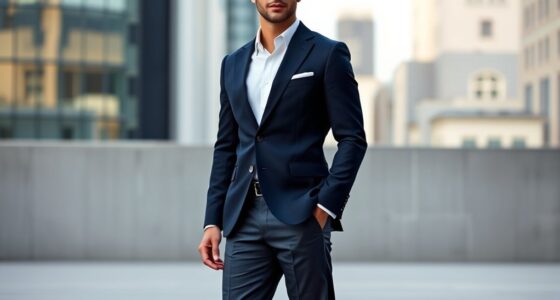Governments worldwide strongly influence the ranking of fashion capitals through policies, incentives, and regulations that promote sustainability, innovation, and ethical practices. Cities like London, Paris, and New York benefit from initiatives supporting eco-friendly fashion and luxury brands, while others like Stockholm and Vietnam emphasize environmental responsibility. These government efforts help enhance each city’s industry leadership and sustainability reputation. If you want to discover which cities lead and how policies shape their success, you’ll find valuable insights ahead.
Key Takeaways
- Cities like Stockholm, London, and Stockholm benefit from strong government incentives promoting sustainable and ethical fashion practices.
- Paris and Milan leverage policies supporting luxury branding and innovation, maintaining their leadership in high-end fashion.
- US and EU initiatives encourage nearshoring and FDI, boosting regional manufacturing and sustainable production efforts.
- Vietnam’s policies aim for fossil-free manufacturing by 2025, aligning with global environmental standards.
- Regulatory frameworks worldwide foster innovation, transparency, and responsible sourcing, shaping fashion capitals’ sustainability leadership.

Fashion capitals around the world are increasingly shaped by government policies that support their industry growth and sustainability efforts. These policies influence everything from manufacturing practices to trade, helping some cities establish dominance in the global fashion scene. In London, the British Fashion Council actively promotes sustainable and ethical fashion through initiatives like London Fashion Week’s “Positive Fashion” space. This emphasis on eco-conscious practices positions London as a leader in responsible fashion, encouraging brands to adopt sustainable standards. Meanwhile, in China, the government provides stimulus measures aimed at boosting luxury demand, which supports domestic fashion brands and influences global trade patterns. These policies help China strengthen its position as a major player in the luxury sector and impact supply chain dynamics worldwide. In Vietnam, recent updates to government decrees in 2025 emerged from advocacy by fashion brands and environmental groups, pushing for fossil-free production and higher sustainability standards. This move aligns Vietnam’s fashion industry with global environmental goals, making it an increasingly attractive manufacturing hub for eco-friendly brands and highlighting sustainable practices essential for industry growth.
Government policies worldwide are driving fashion industry growth and sustainability efforts, shaping global trade and innovation.
Across Europe and North America, government initiatives focus on diversifying and localizing manufacturing. The European Union and US governments incentivize nearshoring and foreign direct investment, with increases of 20 and 8 percentage points respectively over five years. These policies aim to reduce supply chain vulnerabilities while promoting sustainable production practices. In Stockholm, the Swedish government backs a minimalist, eco-friendly fashion industry that emphasizes circular economy principles and eco-materials, solidifying Stockholm’s reputation as a sustainable fashion hub. Similarly, the UK’s government supports London’s efforts to promote responsible fashion, with regulations encouraging the use of recycled fibers and ethical sourcing. Additionally, government funding for innovation and research accelerates the development of new sustainable materials, further strengthening these cities’ leadership in eco-fashion.
Paris continues to dominate the global fashion industry, thanks in part to strong economic indicators like high GDP, wealth levels, and consumer spending power. Government support in France sustains its fashion legacy, with policies that bolster luxury brands and promote innovation. In New York City, authorities back sustainable initiatives, supporting second-hand markets and eco-friendly workshops through grants and policies that foster local production. Milan benefits from Italy’s longstanding “Made in Italy” brand, with government policies that promote luxury heritage and aid global brand expansion. These efforts keep Milan at the forefront of high-end fashion.
Environmental regulations also play a vital role. Stockholm and London have introduced government-backed incentives for using recycled and ethical materials, further cementing their reputations for sustainable fashion. Vietnam’s 2025 decree emphasizes fossil-free manufacturing, reflecting a growing commitment to environmental responsibility. As governments implement stricter emission and waste reduction policies, fashion companies are driven to innovate in inventory management and supply chain agility. Transparency and regulatory frameworks promote sustainable sourcing and supplier collaboration, ensuring brands meet eco-friendly standards. Furthermore, government backing substantially shapes the leadership and direction of the world’s top fashion capitals, influencing industry practices, trade flows, and sustainability commitments across the globe.
Frequently Asked Questions
How Is Government Backing Measured in Fashion Capitals?
You measure government backing in fashion capitals by analyzing funding levels, such as grants and investments in industry initiatives like fashion weeks and export programs. You also look at policy measures promoting sustainability and ethics, talent development efforts, and market access support. Additionally, you assess participation in government-sponsored events, export growth, and qualitative indicators like innovation adoption and brand resilience, often collaborating with independent organizations for transparency and sustainability indices.
Which Cities Are Emerging as New Fashion Hubs?
You’ll notice that cities like Seoul, Tokyo, Shanghai, Singapore, Lagos, São Paulo, and Mexico City are emerging as new fashion hubs. Seoul blends tradition with street style, while Tokyo’s streetwear culture pushes boundaries. Shanghai’s rapid growth is driven by luxury markets, and Lagos fuses modern and traditional designs. São Paulo leads in sustainability, and Mexico City’s vibrant culture influences its fashion scene, positioning these cities as influential, innovative centers gaining global attention.
Does Government Support Influence Local Fashion Industry Growth?
Yes, government support considerably influences local fashion industry growth. When governments promote policies like funding, training, and sustainability legislation, you’ll see more opportunities for brands and artisans to thrive. These initiatives encourage innovation, attract investment, and help small businesses compete globally. By fostering a favorable environment, government backing empowers you and other industry players to develop sustainable practices, expand markets, and strengthen the local fashion scene, ensuring long-term growth and resilience.
How Do Policies Vary Among Top-Ranked Fashion Capitals?
You’ll notice policies differ markedly among top fashion capitals. London offers low taxes and strong sustainability incentives, encouraging innovation and eco-conscious brands. Paris focuses on boosting luxury and creative growth with supportive policies, while Beijing leverages state-owned enterprise backing to maintain manufacturing dominance. New York promotes local sustainable fashion through regulations supporting circular economy principles. These varied policies shape each city’s unique fashion landscape, emphasizing sustainability, innovation, or manufacturing strength.
Are There Any Fashion Capitals Without Government Backing?
You might think every fashion capital is backed by strong government support, but that’s not always the case. Cities like Lagos, Lagos, Mexico City, Johannesburg, and Shanghai are emerging hubs fueled by local talent and market demand rather than official backing. They thrive like wildflowers in an untended garden, growing organically without the formal support of government programs, relying instead on private initiatives, designers, and community-driven efforts.
Conclusion
Now that you’ve seen how governments back their fashion scenes, can you imagine walking through a city where every runway is supported by bold policies and investments? It’s like stepping into a world where creativity and commerce collide, shaping trends before they even hit the streets. When governments champion fashion, they don’t just boost industries—they inspire us all to dream bigger. So, which city will you visit next, knowing it’s a true fashion powerhouse?










